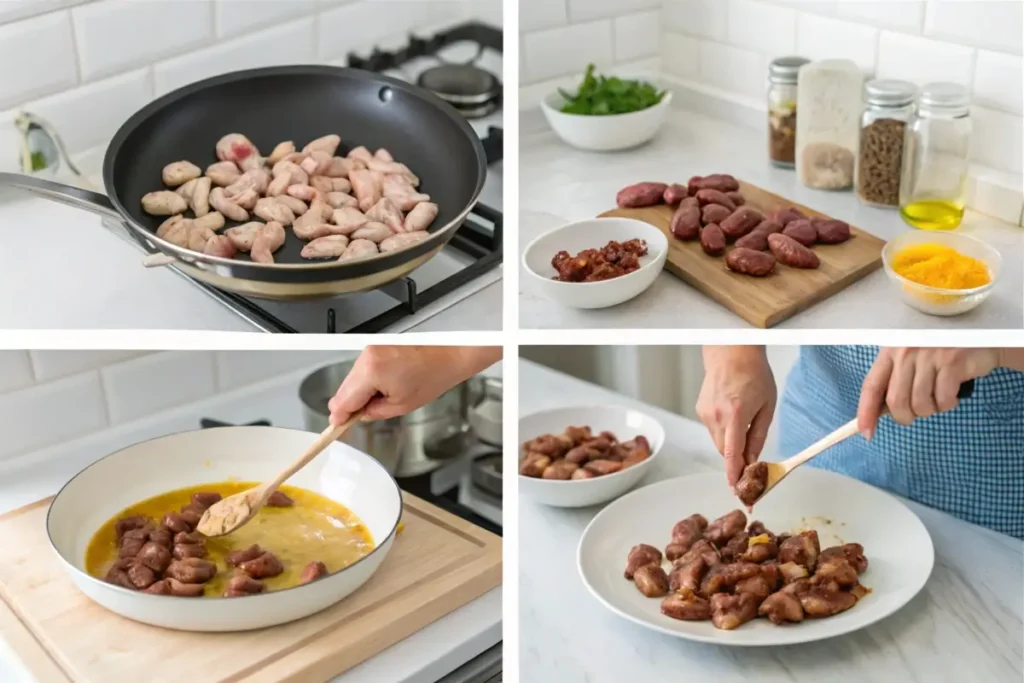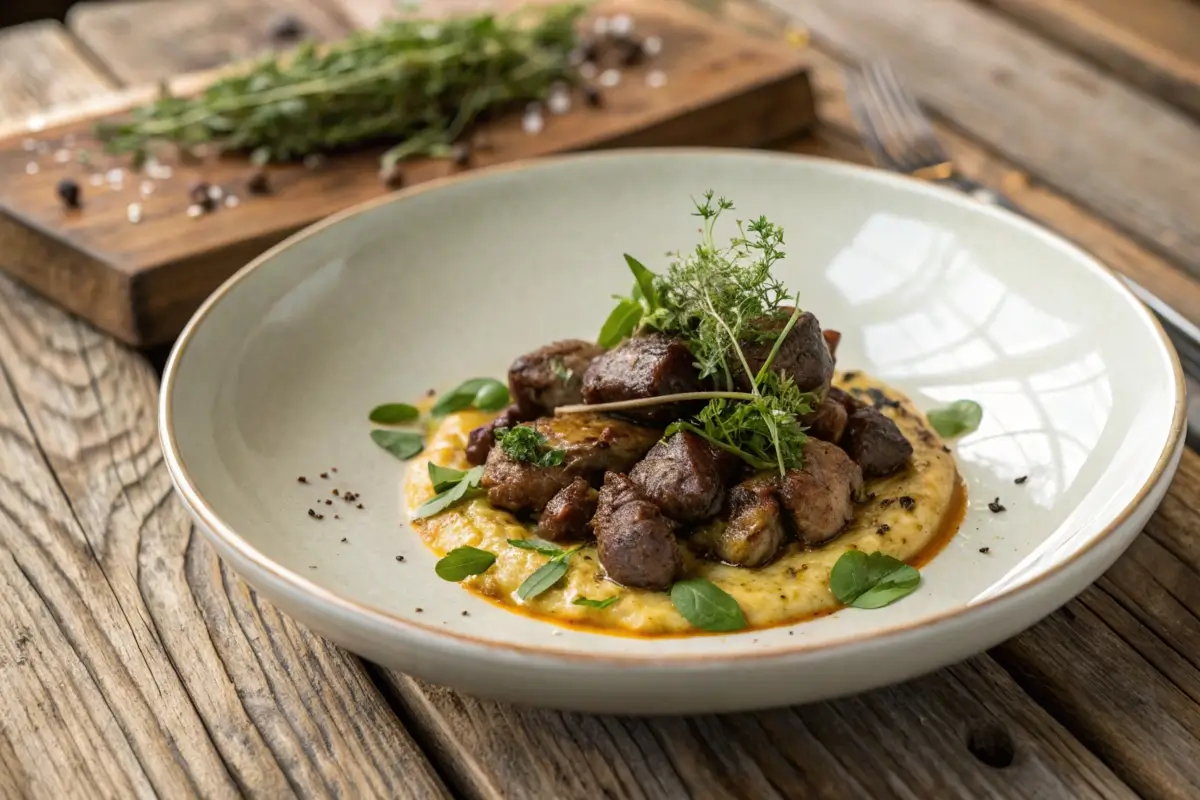Are you looking for unique and flavorful chicken hearts recipes that can elevate your meals? Chicken hearts are not only an affordable protein option but also packed with nutrition and rich in flavor. In this article, you’ll discover a variety of delicious dishes that showcase chicken hearts, from savory stir-fries to hearty stews. Let’s dive into the world of these often-overlooked culinary gems!
What Are Chicken Hearts?
Alright, first things first. What exactly are chicken hearts? The heart is a small organ that pumps blood through the chicken’s body, and let me tell you, when it comes to taste, they pack a punch! Unlike other innards that might get a bad rap, chicken hearts have a rich, meaty flavor that many find irresistible.
Anatomy of Chicken Hearts
So, what do chicken hearts look like? Imagine a bit larger than a marble but smaller than a golf ball, with a stunning red color that instantly draws your eye. They have a chewy texture, which makes them quite different from, let’s say, chicken breast or thigh. There are actually two main parts in a chicken heart: the atria and the ventricles. It’s fascinating how these little organs play such a crucial role in the bird’s life!
Nutritional Profile of Chicken Hearts
Now, here’s where things get interesting. Chicken hearts are not just tasty; they’re surprisingly nutritious! Here’s a quick snapshot of what you’ll find in a typical serving:
| Nutrition Facts (per 100g) | Value |
|---|---|
| Calories | 139 kcal |
| Protein | 14.8 g |
| Total Fat | 6.2 g |
| Saturated Fat | 2.1 g |
| Cholesterol | 224 mg |
| Iron | 8.5 mg |
| Zinc | 3.4 mg |
| Vitamin B12 | 9.4 mcg |
impressive, right? The protein content is particularly high, making them a favorite among fitness enthusiasts and health-conscious eaters alike. Additionally, chicken hearts are packed with iron, which is key for keeping our energy up and our blood vibrant. 🌟
Health Benefits of Chicken Hearts
You might be wondering, “Are chicken hearts really good for me?” Well, the answer is a resounding yes! Here’s why chicken hearts deserve a spot on your plate. First of all, they are packed with essential nutrients, including vitamins and minerals that support overall health. Moreover, their high protein content makes them an excellent choice for those looking to build or maintain muscle. In addition, chicken hearts are versatile and can be incorporated into various dishes, adding rich flavor and texture. So, if you haven’t tried them yet, consider giving chicken hearts a chance in your next meal!
High Protein Content
Let’s talk protein! Whether you’re working out or trying to maintain muscle mass, you need enough protein in your diet. Fortunately, chicken hearts provide a complete source of protein, which means they contain all the essential amino acids your body can’t produce on its own. Thus, it’s like getting a little powerhouse right in your meal!
Rich Source of Vitamins and Minerals
Aside from protein, chicken hearts are also rich in key vitamins and minerals. They offer a treasure trove of Vitamin B12, which helps in the production of red blood cells and keeps your nervous system functioning smoothly. Iron, lauded for its role in oxygen transport, also makes an appearance. It’s a win-win!
Low Fat Alternative for Heart Health
You might think eating heart is kind of ironic, right? But hear me out! Chicken hearts are relatively low in fat compared to other meats. This makes them an excellent alternative for those looking to maintain heart health. Plus, they’re free of harmful additives that can sometimes lurk in packaged meats.
How to Source Quality Chicken Hearts
Now that you’re pumped about the benefits, let’s talk about where to actually get your chicken hearts. You don’t want to just grab any old ones; quality matters!
Choosing Fresh vs. Frozen Chicken Hearts
When selecting chicken hearts, one of the first dilemmas you’ll face is whether to go for fresh or frozen. Fresh chicken hearts are generally preferred for their flavor and texture. However, if you don’t have a local butcher or grocery store that carries them, frozen can be a great alternative. Just remember, quality can vary between brands, so check for any additives if you opt for frozen.
Where to Buy Chicken Hearts
Chicken hearts can be found at various locations:
- Local Butchers: This is often the best place to get fresh, high-quality chicken hearts. Don’t be shy—ask your butcher about where they source their chicken!
- Asian Grocery Stores: Many Asian markets carry chicken hearts, often at very reasonable prices. 🛒
- Farmers’ Markets: If you have access to local farmers, ask if they sell organ meats. Freshness is key!
- Online: For those in areas where chicken hearts are hard to find, there are numerous online retailers that sell them frozen, directly to your door.
With all that in mind, don’t just settle for any chicken hearts. Quality enhances the taste and nutritional value.
Cooking Techniques for Chicken hearts recipes
Here’s where the fun really begins! Once you have your chicken hearts, you might be wondering, “Now what?” Well, you can prepare them in dishes that range from simple to gourmet, and trust me, they’re not as intimidating as you might think. For instance, you can sauté them with garlic and herbs for a quick and delicious meal, or you can use them in hearty stews and stir-fries for added depth of flavor. The possibilities are endless! So, roll up your sleeves and get ready to explore the delicious world of chicken heart recipes!
Grilling Chicken Hearts: Tips and Tricks
Grilling chicken hearts can be an absolute treat! Think of it as a little finger food party! Start by marinating them for at least an hour in your favorite sauce or just olive oil, garlic, and herbs. Preheat your grill to medium heat, skewer the hearts (if you want), and grill for about 3-4 minutes per side.
“Grilled chicken hearts have a smoky flavor that’s simply irresistible. They’re deliciously tender and great on a skewer!”
Stewing and Braising Chicken hearts recipes
If you’re looking for something cozy, then stewing is your best friend. First, start by sautéing onions, garlic, and any spices you like in a pot. Next, add the chicken hearts, some broth, and your favorite vegetables. After that, let everything simmer for about 30-40 minutes. The result? Comfort in a bowl!
Baking Chicken Hearts: A Unique Recipe
Ever tried baking them? It’s easier than you think! Preheat the oven to 375°F (190°C). Place the cleaned hearts in a baking dish, drizzle with olive oil, sprinkle with salt, pepper, and thyme, then cover with parchment paper. Bake for about 25 minutes until they’re golden—talk about a hearty treat! 🍽️
Chicken Hearts in Global Cuisine
You might be surprised to learn that chicken hearts have a notable place in global cuisine. In fact, various cultures have embraced these tasty morsels, and each has added its own unique culinary twists. Therefore, exploring chicken hearts not only introduces you to a delicious ingredient but also opens up a world of diverse flavors from around the globe.
Popular Dishes Featuring Chicken hearts recipes
In Brazil, chicken hearts are often marinated in a zesty mix of spices and then grilled on skewers, famously known as “coração de frango.” 🥢 As a result, this dish makes for a sensational street food experience. Similarly, in Eastern European countries, chicken hearts may find their way into hearty stews, thereby adding that extra depth of flavor. Indeed, who knew chicken hearts could be so versatile?
Chicken Hearts in Various Cultures
You could say chicken hearts bring people together across different cultures. In Middle Eastern cuisine, for instance, you might find them spiced and served as part of a mezze platter, alongside hummus and pita. Imagine digging into those alongside friends and family—what a delightful experience!
Common Problems When Cooking Chicken hearts recipes
Alright, it’s time to get real. Like any ingredient, chicken hearts can present challenges. But don’t worry! We’ll cover some common cooking problems and how to solve them.
Difficulty in Cleaning Chicken hearts recipes
Let’s be honest: cleaning chicken hearts can seem daunting at first. Those little vessels are small and can feel a bit tricky to handle. The first step? Rinse them under cold water to remove any blood or grit. Next, you might find veins or connective tissue that need removing. Just grab a pair of kitchen shears, and it’ll be a breeze! ✂️
Overcooking vs. Undercooking: Finding the Balance
A lot of home cooks struggle with overcooking or undercooking chicken hearts. You don’t want rubbery hearts, but you also don’t want them raw! The key is timing. Cook your chicken hearts on the stove or grill for about 3-4 minutes per side—for a medium-rare finish. If you’re stewing them, they’ll be more forgiving, so don’t stress too much.
Flavor Enhancement Issues: How to Season Chicken hearts recipes
Chicken hearts have a rich, savory flavor, but sometimes you might feel they need a little enhancement. If your dish seems lacking, consider tossing in fresh herbs, spices, or a splash of citrus to brighten things up! For a quick solution, marinate your hearts in soy sauce, garlic, and ginger before cooking. This will elevate the flavor profile and leave your taste buds dancing.
Solutions to Common Cooking Issues
Here are some straightforward solutions to turn those culinary obstacles into delicious triumphs!
Tips for Proper Cleaning and Preparation

Cleaning and preparing chicken hearts doesn’t have to feel like a chore. Try using gloves if you’re squeamish—it allows for a better grip without the yuck factor. As mentioned earlier, kitchen shears can quickly snip away any unwanted bits. And when you rinse them, don’t forget to pat them dry with a paper towel to get that perfect golden crust when cooking!
Cooking Times and Temperatures Explained
When it comes to cooking chicken hearts, the basic rule is to aim for an internal temperature of 165°F (74°C) for safe consumption. To achieve that balance, 3-4 minutes on a grill or skillet is typically sufficient. But remember, if you’re stewing or braising, they cook more gently. When they’re cooked right, they’ll have a tender texture you’ll love!
Flavor Pairing Recommendations
So you want to amp up the flavor? Get creative! Chicken hearts pair beautifully with:
- Garlic and herbs: Think rosemary, thyme, or basil.
- Spices: Cumin, paprika, or a spicy kick from chili pepper.
- Acidity: A hint of lemon juice or balsamic vinegar can really enhance the flavors.
Consider these ingredients your culinary companions on a flavor adventure! 🌈
Chicken hearts recipes vs. Other Offals: A Comparison
You might be wondering how chicken hearts stack up against other organ meats. Let’s break it down!
Nutritional Differences
When compared to other offals like liver or kidney, chicken hearts are lower in calories while still packing a protein punch. They are leaner, which makes them appealing if you’re looking for a lower-fat option without sacrificing nutrition.
Culinary Versatility
In culinary uses, chicken hearts can be prepared in many ways, while liver, for example, tends to dominate in pâté recipes. Chicken hearts can shine on their own or be a delightful addition to soups, stews, and grilled dishes. Their unique texture allows them to absorb flavors beautifully, making them a versatile option in any kitchen.
FAQ About Chicken hearts recipes
Can You Eat Chicken hearts recipes Raw?
As tantalizing as it might sound, eating raw chicken hearts isn’t advisable. Moreover, like all poultry, chicken hearts can carry harmful bacteria. Therefore, it is essential to always ensure they are cooked to the proper temperature to keep yourself safe and healthy.
How Long Do Chicken hearts recipes Last in the Fridge?
When planning ahead, chicken hearts can typically last in the fridge for about 1-2 days once cooked. For raw hearts, they usually stay good for about the same duration. If you find yourself with extras after a cook-off, consider freezing them; they can last up to 3 months in the freezer—just remember to seal them well! ❄️
Conclusion:
And there you have it—a comprehensive look at chicken hearts! 🥳 From their impressive nutritional profile to various cooking techniques and cultural significance, these delicious little morsels undoubtedly deserve a place in your kitchen. Additionally, as you experiment with chicken hearts, don’t be afraid to share your culinary creations.
Ultimately, cooking should be fun and adventurous, so get out there and take your taste buds on an unforgettable journey! Moreover, next time you’re at the grocery store or farmers’ market, don’t overlook those chicken hearts. They aren’t just a quirky ingredient; instead, they’re a powerhouse of goodness waiting to elevate your meals. Wishing you all the best in your culinary endeavors—happy cooking! 🎉

